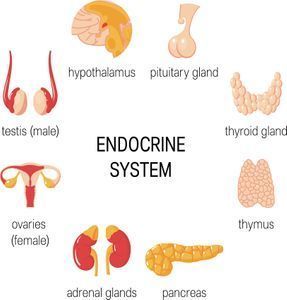Congenital Adrenal Hyperplasia
Congenital adrenal hyperplasia (CAH) is the result of a deficiency in one of the enzymes in cortisol biosynthesis. In about 95% of cases of congenital adrenal hyperplasia, the disorder is in the area of the adrenal cortex fasciculata, so that 17-hydroxyprogesterone (17-OHP) is not converted to 11-deoxycortisol. ACNT levels increase due to defective cortisol synthesis, leading to overproduction and accumulation of cortisol precursors, particularly 17-OHP. As a result, excessive androgen production occurs leading to virilization.
Diagnostic Range: Genetic variants in the genes: CYP21A2
Diagnostic Method: Sanger sequencing / MLPA
Research Material: 6 ml venous blood / 2 ml peripheral blood
Results within: 10 business days
Fee: Sanger - BGN 1,200 / MLPA - BGN 800
Clinical application
Adrenogenital syndrome
Type 2 Diabetes
Advances in genetics in recent years have found polymorphisms in the genome which, in combination with different genotypes, could provide information on a predisposition to developing type 2 diabetes.
Diagnostic Range: Genetic variants in the genes TCF7L2, FTO are analyzed
Diagnostic Method: Sanger sequencing/ RFLP
Research Material: 6 ml venous blood / 2 ml peripheral blood
Results within: 5 business days
Fee: BGN 200
Clinical application
Type 2 Diabetes
IDO Activity
Indolamine-2,3-dioxygenase is an enzyme that metabolizes the amino acid tryptophan (TRP) and kynurenine. It occurs in a number of tissues and cells, such as the small intestine, lungs, female genital tract or placenta.
IDO is an important part of the immune system and plays a role in the natural defense against various pathogens. It is produced by cells in response to inflammation and has an immunosuppressive function due to its ability to limit T cell function and to involve mechanisms of immune tolerance. IDO activity is low under normal physiological conditions, but is dramatically increased by the presence of proinflammatory cytokines such as interferon-γ. This short-term activation of IDO occurs as part of the innate immune response and helps inhibit the growth of pathogens and parasites.
Diagnostic Range: Quantification of Indolamine-2,3-Dioxygen activity; Tryptophan; Kynurenine
Diagnostic Method: ELISA
Research Material: 2 ml of serum
Results within: 15-20 business days
Fee: BGN 168
Clinical application
Arthritis; Alzheimer's; Atherosclerosis; Osteoporosis; Diabetes; Crohn's disease; Ulcerative colitis
Premature Ovarian Failure
Premature ovarian failure (POF)— also called Primary ovarian insufficiency (POI) - occurs when the ovaries stop functioning normally before age 40. POF is one of the main causes of infertility in women. In 1-2% of them, POF is observed before the age of 40 and about 0.1% before the age of 30.
POF can be appear very early as a defect in puberty. Depending on the age of occurrence the disorders can manifest as primary amenorrhea (PA), without a first menstrual cycle (menarche) or secondary amenorrhea after puberty. The etiology of POF is highly heterogeneous with 12% of cases being chromosomal abnormalities. Family history is very common.
Diagnostic Range: NR5A1, BMP15, FMR1, FSHR, GNRHR, NOBOX и FIGLA
Diagnostic Method: Sanger sequencing
Research Material: 3-6 ml venous blood/peripheral blood
Results within: 10 business days
Fee: FMR1 - BGN 150; FOXL2 - BGN 250; FIGLA - BGN 300; BMP15 - BGN 300; NOBOX - BGN 600.
Clinical application
Premature ovarian failure; Genetic predisposition; Reproductive failures
Vitamin B6
Vitamin B6 is an important factor in the formation of the red blood cells, the developing of nervous tissue, the detoxification processes, the DNA synthesis, the cell energy balance and the immune protection. It is also a key factor in the methylation processes that regulate the "unlocking" or "locking" of our genes. Methylation disorders can lead to elevated homocysteine levels, which are associated with a large number of diseases.
Vitamin B6 Genetic Panel includes analysis of genetic variants associated with faster degradation of vitamin B6 and systemically low bioavailability of its active form, called Pyridoxal-5-phosphate. The results contain interpretation, clinical significance of identified variants and recommendations to assist specialists in making therapeutic decisions.
Diagnostic Range: Genetic variants associated with deficiency and faster degradation of Vitamin B6
Diagnostic Method: Sanger sequencing
Research Material: 3-6 ml venous blood / 2 ml peripheral blood
Results within: 10 business days
Fee: BGN 150
Clinical application
Metabolic disorders; Eating disorders
Vitamin B12
Vitamin B12 is supplied only with food. It is a key factor in to the functioning of vital body processes, including the formation of red blood cells, DNA synthesis, normal nervous system function, digestion. If Vitamin B12 deficiency is not managed in time, it can lead to anemia, a number of gastrointestinal, neurological, oncological, and other diseases.
Vitamin B12 Genetic Panel includes analysis of genetic variants associated with disorders in the absorption of the vitamin in the small intestine, reduced transport to the liver and faster depletion of its active form.
The results contain interpretation, clinical significance of identified variants and recommendations to assist specialists in making therapeutic decisions.
Diagnostic Range: Absorption, transport and use of vitamin B12 in the body.
Diagnostic Method: Sanger sequencing/ RFLP
Research Material: 3-6 ml venous blood / 2 ml peripheral blood
Results within: 10 business days
Fee: BGN 280
Clinical application
Neurology; Hematology; Endocrinology; Gastroenterology; Psychiatry Anemia
